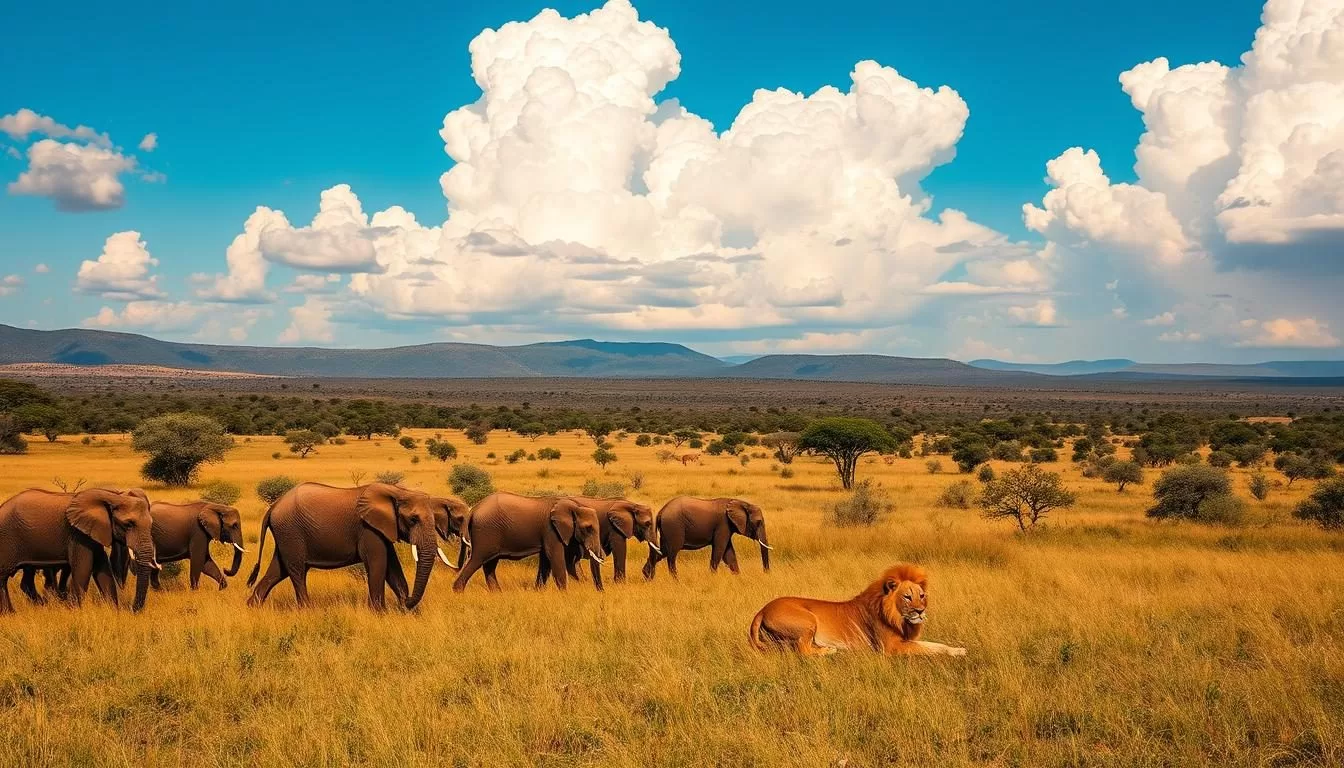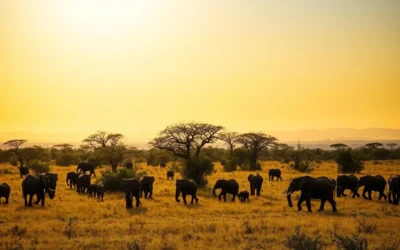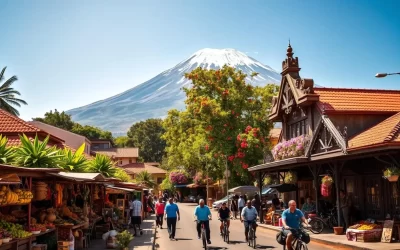✓ Accommodations✓ Flights✓ Rental Cars✓ Tours & Activities
Planning a trip to Tanzania requires more than just picking a destination; it demands timing your visit right. The country’s diverse climate zones create distinct experiences throughout the year, making the season you choose to visit crucial for your adventure.
The weather in Tanzania varies significantly, with a main rainy season during March, April, and May, followed by a long dry season from June to October. Understanding these patterns is key to enjoying optimal wildlife viewing and comfortable travel conditions.
By choosing the right time for your visit, you can align your travel dates with your specific interests, whether you’re a wildlife enthusiast or looking for a relaxing getaway. This guide will help you navigate Tanzania’s climate to make the most of your trip.
Understanding Tanzania’s Climate Patterns
Tanzania’s vast size and diverse geography result in varied climate conditions across the country. The country’s extensive size means that the climate varies considerably within it, influenced by factors such as elevation, proximity to large bodies of water, and the presence of different topographical features.

Dry Season vs. Wet Season
Tanzania experiences two main seasons: the dry season and the wet season. The dry season, which typically runs from June to October, is characterized by dry and sunny weather, making it ideal for wildlife viewing in national parks like the Serengeti. In contrast, the wet season, spanning from November to May, brings significant rainfall, resulting in lush landscapes and fewer tourists.
| Season | Characteristics | Best For |
|---|---|---|
| Dry Season (June-October) | Dry, sunny, comfortable temperatures | Wildlife viewing, safaris in national parks |
| Wet Season (November-May) | Lush landscapes, fewer tourists, occasional rain | Photography, birdwatching, budget travel |
Regional Climate Variations
The climate in Tanzania varies significantly across different regions. The northern circuit, which includes areas like the Serengeti and Ngorongoro, has a distinct climate compared to the southern and western circuits. For instance, the Ngorongoro Highlands are generally cooler than the Serengeti plains due to their higher elevation. Additionally, coastal areas such as Dar es Salaam and Zanzibar experience higher humidity and different rainfall patterns compared to inland regions.
Understanding these regional variations can help you plan your trip to Tanzania more effectively, choosing the best areas to visit based on the season and your preferences.
Tanzania: Best Months for a Weather-Savvy Trip
To make the most of your Tanzanian adventure, it’s essential to know the best months to visit based on weather and wildlife activity. Tanzania’s climate varies significantly across different regions and seasons, impacting the quality of your safari experience.
Peak Season: June to October
The peak tourist season in Tanzania, from June to October, offers the best weather conditions for safaris. During this period, the weather is generally dry and cool, making it ideal for wildlife viewing. The dry conditions concentrate animals around water sources, making them easier to spot. This is also the best time to visit if you’re interested in witnessing the Great Migration river crossings.
The dry season also means that the roads are more accessible, and safari activities are less likely to be disrupted by weather. However, this is the busiest period, and popular destinations can be quite crowded.
Shoulder Seasons: January-February and November
For travelers looking for a more balanced experience between weather and tourist numbers, the shoulder seasons of January-February and November are worth considering. January and February follow the short rains and offer a short dry season with lush landscapes, making for excellent photography conditions.
- The wildebeest calving season in the southern Serengeti during January and February is a highlight, attracting predators and offering dramatic wildlife spectacles.
- November marks the onset of the short rainy season, but the rains are typically short and infrequent, rarely disrupting safari activities.
- These periods offer better value with lower accommodation rates and fewer tourists at popular spots.
- The landscapes are particularly vibrant and photogenic during these transitional periods.
By considering these shoulder seasons, you can enjoy a more relaxed and potentially more rewarding Tanzanian adventure, with the added benefit of lower costs and unique photographic opportunities.
The Great Wildebeest Migration Calendar
As you plan your Tanzanian adventure, understanding the Great Wildebeest Migration calendar is crucial for maximizing your wildlife viewing opportunities. The Serengeti wildebeest migration is a dynamic and ever-changing spectacle, with different phases occurring throughout the year.
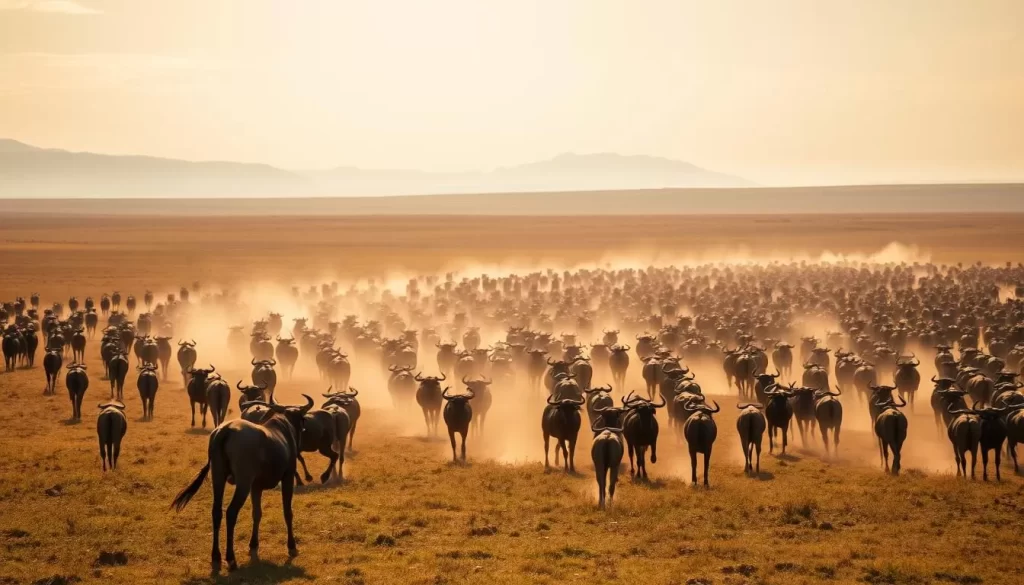
Calving Season: January to February
During January and February, the southern Serengeti plains become the nursery for over 1.5 million wildebeest, as they give birth to their young. This period, known as the calving season, is a critical phase in the wildebeest life cycle. The abundance of newborns attracts predators, making it a thrilling time for wildlife enthusiasts.
River Crossings: July to September
As the dry season progresses, the herds begin their journey northwards towards the Maasai Mara, crossing the Grumeti and Mara rivers along the way. These river crossings, which typically occur between July and September, are among the most dramatic moments of the migration, as the wildebeest face off against crocodiles and other predators.
Migration Route Throughout the Year
The great wildebeest migration is not a static event; it is a continuous process that unfolds throughout the year. To help you better understand this phenomenon, here’s a breakdown of the migration’s key phases and locations:
| Month | Location | Key Events |
|---|---|---|
| January-February | Southern Serengeti | Calving season |
| July-September | Western Corridor and Maasai Mara | River crossings |
| November-December | Southern Serengeti | Return journey begins |
By understanding the migration patterns throughout the year, you can plan your visit to coincide with the events that interest you most, whether it’s witnessing the newborn wildebeest or the perilous river crossings.
Visiting Tanzania During the Dry Season: June to October
Tanzania during the dry season, from June to October, is a paradise for wildlife enthusiasts and adventure seekers alike. This period is considered the best time to visit Tanzania due to its favorable weather conditions and the abundance of wildlife viewing opportunities.
Wildlife Viewing Advantages
The dry season offers excellent wildlife viewing due to the dry vegetation and the concentration of animals around water sources. During this time, the Great Wildebeest Migration is in full swing in the Serengeti, with August and September being the peak months for witnessing the dramatic Mara River wildebeest crossings.
You can also witness significant elephant concentrations in Tarangire National Park, where hundreds gather along the Tarangire River during the driest months. The dry season’s clear skies and firm ground make it an ideal time for various safari activities, including traditional game drives and walking safaris.
Weather Conditions and What to Pack
During the dry season, Tanzania experiences pleasant weather, characterized by clear skies and mild temperatures, ranging from the mid-60s to mid-80s Fahrenheit (18-30°C). It’s essential to pack layers for your trip, including warm clothing for cooler mornings and evenings, as well as sun protection such as hats, sunglasses, and sunscreen.

Popular Activities and Safari Experiences
The dry season is an excellent time for a variety of safari experiences. You can enjoy balloon safaris over the Serengeti, offering breathtaking aerial views of the wildlife and landscapes below. The dry conditions also make it an ideal time for walking safaris and night safaris, which are enhanced by the clear night skies and the concentration of wildlife around water sources.
Additionally, the predictable weather during this season allows for combining safari activities with other adventures, such as climbing Mount Kilimanjaro or Mount Meru. You can also explore unique dry season activities offered by specific lodges and camps, including hide photography and specialized walking programs.
Visiting Tanzania During the Wet Season: November to May
The wet season in Tanzania, spanning from November to May, offers a distinct perspective on the country’s wildlife and landscapes. While it’s often considered the low season, this period has its unique advantages and experiences that are worth exploring.
Green Season Benefits
During the wet season, Tanzania transforms into a lush and vibrant landscape. The scenery is green and beautiful, making it an ideal time for photography and nature walks. Migratory birds are present from November to April, making bird watching a highlight of the season. January to February is particularly notable for the wildebeest calving in Southern Serengeti, offering a chance to witness newborn wildlife and increased predator activity.
The green season also brings numerous benefits for wildlife viewing. With an abundance of food and water, animals are more dispersed, and the lush vegetation creates a picturesque backdrop for safari adventures.
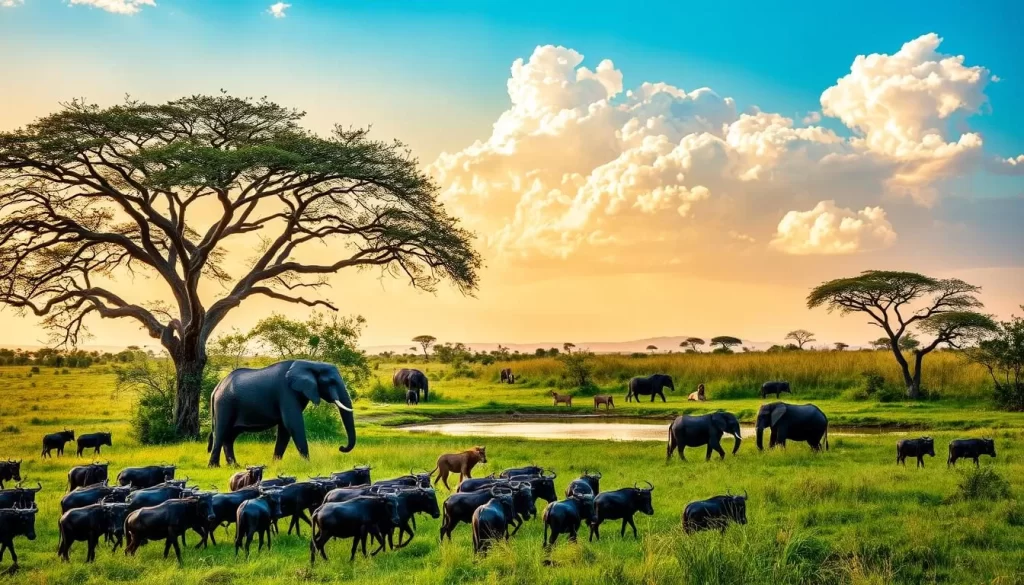
Weather Challenges and Considerations
While the wet season has its advantages, it’s essential to be prepared for the challenges it brings. The rain can make some roads impassable, and certain areas may be closed due to flooding. Visitors should pack accordingly, bringing waterproof gear and sturdy boots to navigate the wet conditions.
Despite these challenges, many tour operators offer specialized wet season safaris and activities that take advantage of the unique conditions.
Unique Experiences and Photography Opportunities
The wet season creates extraordinary photography opportunities with dramatic skies, rainbows, and the striking contrast of wildlife against lush green backgrounds. The changing light conditions, from moody storm clouds to brilliant post-rain clarity, create dynamic and atmospheric photography scenarios.
Visitors can also observe special wildlife behaviors during the rainy months, including mating rituals and unique feeding patterns not visible during the dry season. The calving season, which coincides with the green season, offers a chance to see newborn wildlife and the increased predator activity that follows.
Specialized activities like photography workshops and birding safaris are available, taking advantage of the unique conditions. With the right preparation and mindset, visiting Tanzania during the wet season can be a rewarding and memorable experience.
Month-by-Month Guide to Tanzania
Understanding the best time to visit Tanzania can significantly enhance your safari experience. Tanzania’s climate and wildlife patterns vary throughout the year, making some months more suitable for certain activities than others.
January and February: Calving Season
January and February are excellent months for witnessing the wildebeest calving season in the Serengeti. The southern part of the Serengeti is usually teeming with newborn wildebeest calves, making it a spectacular time for wildlife viewing. The presence of predators like lions and hyenas is also higher during this period, as they prey on the vulnerable newborns. The weather is generally warm and dry, with average highs around 28°C (82°F).
March to May: The Long Rains
The long rainy season, which spans from March to May, transforms Tanzania’s landscapes into lush, green vistas. While this period can be challenging for some safari activities due to the rain, it also brings about unique opportunities. The rainforests are particularly beautiful, and the birdlife is abundant. Migratory birds are present, and the scenery is vibrant. However, some areas may become inaccessible due to the rains.
| Month | Weather | Wildlife Activity |
|---|---|---|
| March | Start of long rains | Migratory birds arrive |
| April | Peak rainy season | Landscapes are lush and green |
| May | Rains begin to subside | Wildlife viewing starts to improve |
June to October: Prime Safari Season
The dry season, from June to October, is considered the prime time for safaris in Tanzania. The weather is dry and mild, making it ideal for wildlife viewing. The Great Migration reaches its peak during these months, with dramatic river crossings in July and August. The concentration of wildlife around water sources makes it easier to spot animals.
- The dry conditions make it easier to navigate the parks.
- Wildlife viewing is at its best due to the concentration around water sources.
- The Great Migration is a highlight, with river crossings being a thrilling spectacle.
November and December: Short Rains
November and December bring the short rains, a period characterized by lighter and less predictable rainfall compared to the long rains. This season offers a unique blend of green landscapes and relatively good wildlife viewing conditions. The short rains rejuvenate the vegetation, and the arrival of migratory birds adds to the richness of the wildlife experience.
During these months, you’re likely to enjoy fewer tourists, making for a more intimate safari experience. The wildebeest herds begin their migration back into the Serengeti, and the scenery remains lush and vibrant.
Best Times for Northern Circuit Safaris
Tanzania’s Northern Circuit offers some of the most spectacular safari experiences, but timing is crucial for making the most of your trip. The region is home to diverse wildlife and landscapes, with each park offering unique experiences throughout the year.
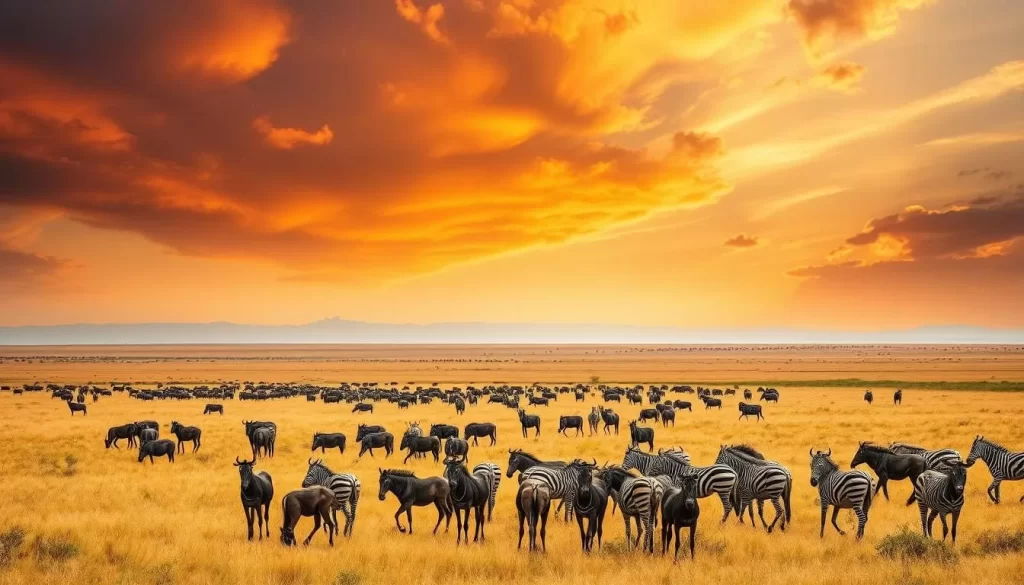
Serengeti National Park
The Serengeti is famous for the Great Wildebeest Migration, a spectacle that typically peaks between July and September. However, the park is a year-round destination, with each season offering something unique. During the dry season, wildlife viewing is excellent as animals congregate around water sources.
Ngorongoro Crater
The Ngorongoro Crater is another highlight of the Northern Circuit, known for its dense wildlife populations. The crater’s unique ecosystem supports a wide variety of animals, including the Big Five. Visiting during the dry season can be particularly rewarding due to the high concentration of wildlife.
Tarangire and Lake Manyara
Tarangire National Park is renowned for its large elephant populations and majestic baobab trees. The dry season, from June to October, is the best time to visit Tarangire, as elephants congregate along the Tarangire River. Lake Manyara National Park, on the other hand, is famous for its tree-climbing lions and diverse birdlife, making it a great destination for birders year-round.
Understanding the seasonal dynamics of these parks can greatly enhance your safari experience. By planning your visit according to the season, you can witness incredible wildlife spectacles and enjoy the unique attractions of each park.
Best Times for Southern and Western Circuit Safaris
Tanzania’s Southern and Western Circuit safaris offer a unique and off-the-beaten-path experience, with the best times to visit varying depending on the park and wildlife you’re interested in.
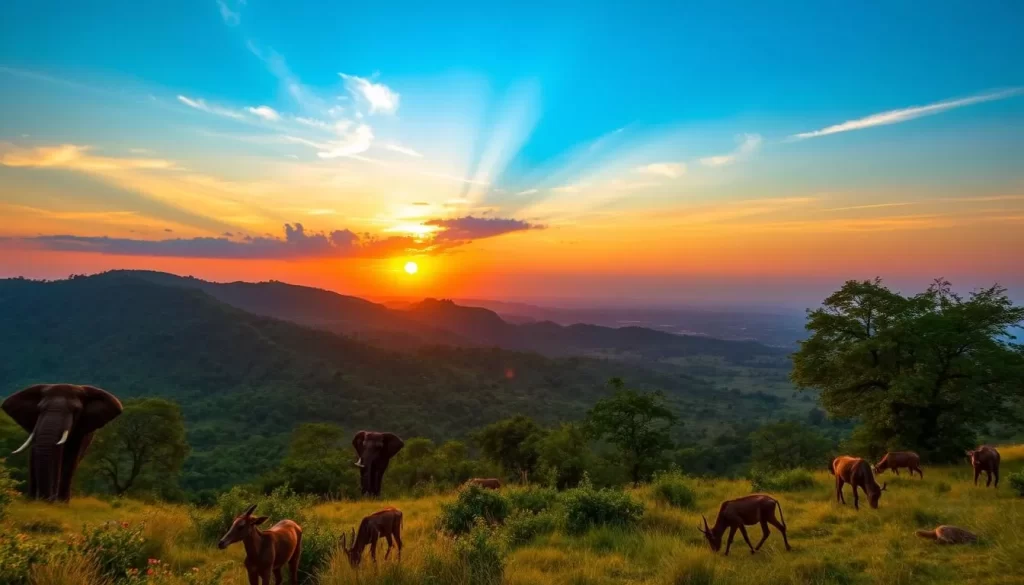
Nyerere National Park (Former Selous)
Nyerere National Park, formerly known as Selous, is a vast and diverse park that’s home to a wide range of wildlife. The best time to visit is during the dry season, from June to October, when animals congregate around water sources, making them easier to spot.
Ruaha National Park
Ruaha National Park is known for its large elephant populations and diverse wildlife. The dry season, from May to October, is the best time to visit, as the dry conditions make it easier to spot animals.
Katavi and Mahale Mountains
Katavi National Park, located in the Western Circuit, is renowned for its high concentrations of hippos and crocodiles during the dry season. Mahale Mountains National Park is famous for its chimpanzee tracking experiences, with the dry season offering the best conditions for trekking.
Visiting these parks requires careful planning due to their remote locations. Some camps are only open during specific months, and flight schedules operate more frequently during certain times of the year.
Weather Considerations for Tanzania’s Coastal Areas and Zanzibar
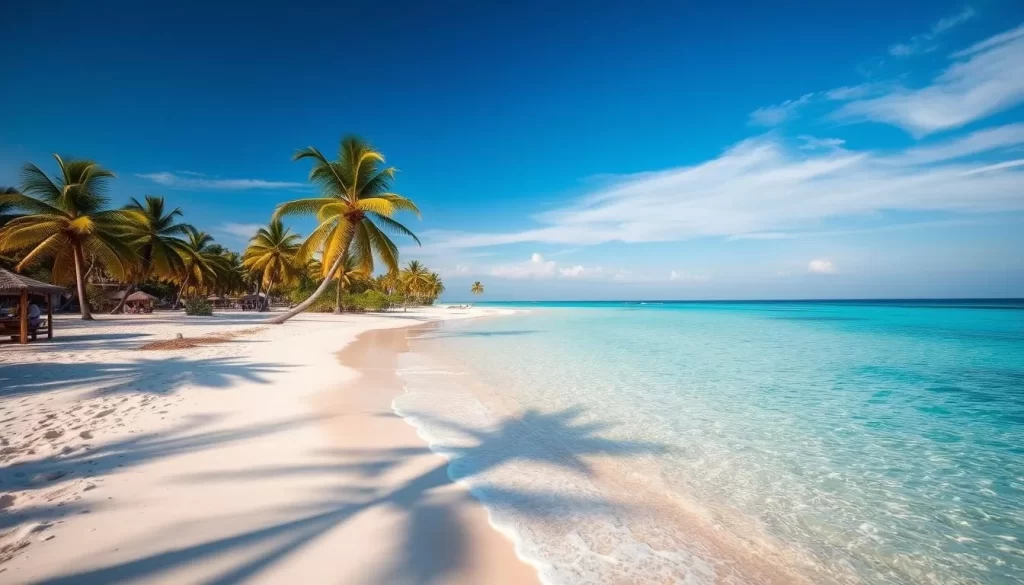
When planning a trip to Tanzania, considering the best time to visit both the mainland and coastal areas like Zanzibar is crucial for an optimal experience. Tanzania offers the opportunity to combine wildlife safaris with beach relaxation on Zanzibar or other coastal areas.
Beach Season Weather Patterns
The dry season, from June to October, is generally considered the best time to visit Zanzibar and other coastal areas of Tanzania. During this period, the weather is sunny and dry, making it ideal for beach activities and water sports.
The coastal regions experience a tropical climate, with temperatures varying throughout the year. Understanding these patterns can help you plan your trip accordingly.
Combining Safari and Beach Holidays
The best time for combining safari and beach holidays in Tanzania is during the dry season from June to October when safari conditions are optimal and coastal weather is sunny and dry. This period offers the most reliable excellent conditions for both safari and beach components.
You can also consider January and February as alternative good periods for this combination, as both safari viewing (especially in the Serengeti) and coastal conditions are favorable during these months.
Planning Tips for Different Traveler Types
Tanzania offers diverse experiences for various types of travelers, from wildlife enthusiasts to budget travelers and families. Understanding your travel preferences is key to a memorable trip.
Wildlife Enthusiasts and Photographers
For wildlife enthusiasts and photographers, the dry season (June to October) is ideal, offering excellent wildlife viewing as animals congregate around water sources. The northern circuit, including Serengeti National Park and Ngorongoro Crater, is particularly popular during this time. You’ll have opportunities to capture stunning images of the Great Wildebeest Migration and other wildlife.
Budget Travelers
Budget travelers can benefit from visiting during the shoulder season (April to May or November to December), when prices are lower, and crowds are smaller. The wet season can also provide a lush, green landscape, ideal for photography. Consider budget-friendly accommodations and safari options to save on costs.
Families with Children
Families with children can enjoy Tanzania’s safaris during the dry season, which coincides with school holidays in July-August and December-January. The northern circuit is family-friendly, with many lodges and tour operators catering to families. Activities like game drives, walking safaris, and cultural visits can be adapted for children, making for a fun and educational experience.
Conclusion
Tanzania’s diverse climate means that the best time to visit varies greatly depending on your interests. As you’ve learned, the country’s seasonal patterns significantly impact wildlife viewing, comfort levels, and budget considerations.
Whether you’re a wildlife enthusiast or a budget traveler, every month offers unique advantages and special experiences. The Great Wildebeest Migration, a highlight of any Tanzanian safari, is a year-round phenomenon, with different aspects visible throughout the seasons.
By understanding Tanzania’s varied climate zones and the guide provided, you can tailor your itinerary to maximize conditions in specific regions during any given month. This guide serves as your seasonal roadmap to Tanzania, helping you align your travel dates with the experiences that matter most to you.
With this knowledge, you’re now equipped to make an informed decision about the best time for your Tanzanian adventure, ensuring a truly unforgettable African experience.
The above is subject to change.
Check back often to TRAVEL.COM for the latest travel tips and deals.
